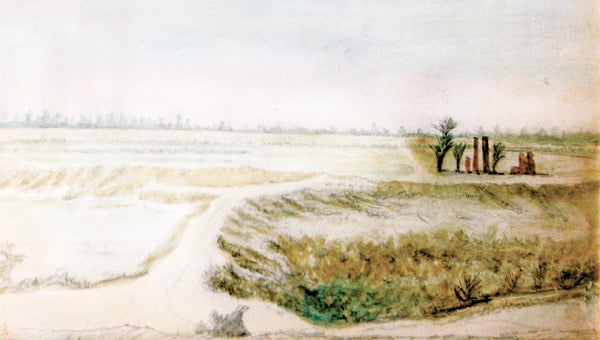Costly Information
Published 9:59 pm Tuesday, April 30, 2013

This is one of four water color paintings recently obtained by Riddick’s Folly, that shows the plain over which the 99th New York Infantry advanced against the entrenched Confederate infantry. (Courtesy of Riddick’s Folly)
Editor’s Note: To mark its 150th anniversary, through May 4, the Suffolk News-Herald will feature a multi-part series by Suffolk historian Kermit Hobbs detailing the 23-day Siege of Suffolk.
By Kermit Hobbs
Special to the News-Herald
Friday, May 1, 1863
Part 13: The charge of the 99th N.Y. Infantry
From the beginning of the Suffolk Campaign, Confederate Gen. James Longstreet had been working under several constraints.
He was to protect the southern approaches to Richmond, which he was effectively doing. He was to strike a blow at the Yankees whenever possible. He had been somewhat aggressive early in the siege, but after the loss of Fort Huger, his actions had been more defensive in nature. He was to gather as much food and supplies as possible for the Confederate Army, as quickly as possible.
He also had to be ready to pull away from Suffolk quickly to rejoin Robert E. Lee’s Army of Northern Virginia if it became necessary.
The entire foraging process had been expected to take no more than two weeks, but by now it had gone on for three. The April weather had dried up the roads nicely, making the threat of a Union advance on Richmond a greater possibility.
In fact, this is exactly what was happening. Just one day earlier, on April 30, Longstreet had received a simple command from the Adjutant and Inspector General in Richmond: “Move without delay with your command to this place to effect a junction with General Lee.”
Gen. Joseph Hooker was preparing for an attack on Richmond. Longstreet had one third of the Lee’s Confederate Army in Suffolk, and those soldiers would be desperately needed.
On the other side of the trenches, Union Gen. John Peck understood exactly what was happening. He knew, of course, that Hooker’s Army of the Potomac was moving toward Richmond, and he believed some of Longstreet’s troops that had been surrounding Suffolk might be slipping away to Richmond.
To test his theory, Peck ordered the 99th New York Infantry to advance along South Quay Road to test the strength of the Confederates along that front.
The road they knew as South Quay Road was what we now call Holland Road. At that time, the road crossed the dam that formed Kilby’s Mill Pond (Lake Kilby) and continued across what is now Suffolk Golf Course. The entire area west of the lake had been cleared of all vegetation to make a clear field of fire. The Union “South Quay Battery” stood on the bank at the present water works and faced across the lake.
Late in the afternoon, 210 men of the 99th New York crossed the dam and the bridge leading to the Confederate positions. Once across, before they moved up the hill and into view of the Confederates, they fanned out into a wide line. They then moved up and over the barren plain toward the enemy, while Union artillery from Fort Nansemond, the South Quay Battery, and Fort Rosecrans pounded the Rebel defensive line hundreds of yards ahead.
On the Confederate side of the field, one portion of the line was manned by the 55th North Carolina Infantry, the very regiment that had been disgraced at the loss of Fort Huger. The unit’s honor had been tarnished, and its members would now do anything to restore their reputation. Commanding them was none other than Maj. A.H. Belo, one of the people involved in the duel a few days earlier.
The 55th North Carolina was armed with outdated smoothbore muskets that were ineffective at more than a hundred yards, so they were at a severe disadvantage to the approaching Yankees.
Belo, understanding this, made a bold move. He had his men hold their fire until the 99th New York Infantry was almost upon them. Then they cut loose with devastating effect. The initial volley set the tone for the carnage that followed.
One observer watching from the Union side stated, ”As the fire grew hot and furious … the men dropped by tens … Three times I saw the stars and stripes fall, but they were caught up again in an instant and floated out as bravely as ever.”
The battle raged on with devastating effect upon the New Yorkers. Finally, the bugle at South Quay Battery sounded “Retreat,” but it had to be repeated several times before the survivors of the 99th heeded its call. Then they began, singly and in groups, to withdraw across the field to the safety of their camps, enduring the fire from the Confederates as they retreated.
Gen. Peck now knew what he needed to know: The Rebels were still in force around Suffolk.
It was a costly bit of information.
Friday: Part 14 — The Battle of Providence Church Road





